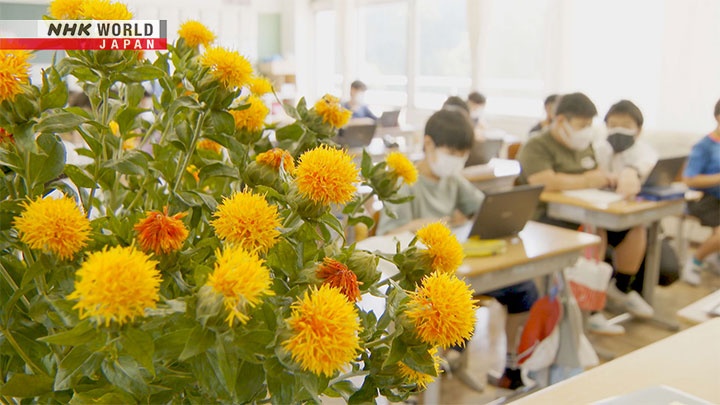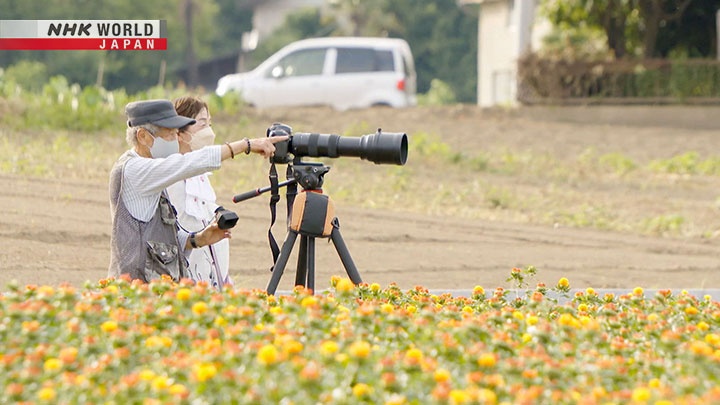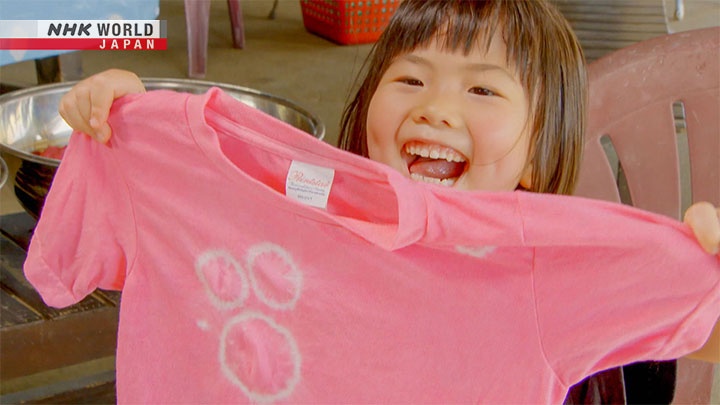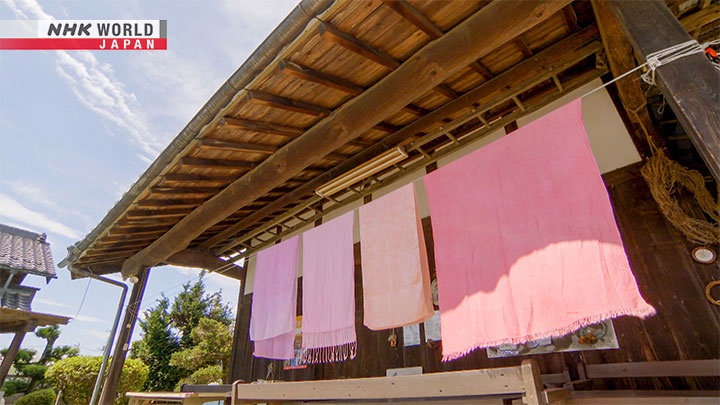The Treasured Red of Benibana Flowers―Okegawa, Saitama Prefecture
Nestled in the heart of the Kanto Plain, Okegawa in Saitama Prefecture has prospered through the cultivation of benibana, or safflower, since the Edo period. The flower was in high demand as a natural dye, but the industry suffered a decline with the emergence of chemical dyes. However, local residents have been working tirelessly for the past three decades to revive cultivation. This program introduces the stories of various individuals in Okegawa who are deeply connected to the red flower. We meet a farmer who inherited her benibana field from her father and passionately safeguards it with the help of her young children. A husband and wife eagerly anticipate benibana season and visit the fields annually to capture their beauty through photography. We also meet a woman who devotes herself to benibana dyeing alongside her circle of friends, not once forgetting about the precious memories of her late husband. Explore the lives of these individuals who protect benibana and find solace in their crimson blossoms.




Transcript
A rural scenery of fields and rice paddies spreads out in Okegawa, Saitama Prefecture.
It's a commuter town, located about 40 minutes by train from Shinjuku.
The street running through the center of Okegawa is the former Nakasendo route,
one of the five major routes of the Edo Period, when the city prospered as a rest area for travelers.
We find an event bustling with people.
It's the annual Benibana, or safflower, Festival.
It's "benibana" jam.
What's over here?
They have sweet buns.
This is the most popular item.
I'm going to choose a pretty one.
Bouquets of benibana.
Hello. These are beautiful.
Would you like one?
They're 300 yen a bouquet.
That's cheap.
You get small yellow flowers first.
They then turn red.
They don't bloom at once,
so when you make a bouquet,
you get a mix of yellow and red.
Komine Satomi is a local who once left Okegawa.
Since returning to her hometown, she's been growing benibana.
They can be enjoyed
for about a year as dried flowers.
Oh, is that so?
This is Komine's field in the suburbs, where she grows ornamental benibana.
It's mid-June, harvest season.
Helping out on the farm is her son, Kyoichi.
Her two daughters Miyuu and...
... Miori also help out.
Benibana has long been used to make red dye.
Initially, when they bloom, the flowers are yellow, but they gradually turn red.
The buds are surrounded by thorns.
Although cultivar improvement has helped reduce these pricks, caring for benibana is still no easy task.
I'm sure these babies
need thorns to survive.
So I wish there were no thorns,
but I don't think we can
completely get rid of them.
You call them "babies?"
Yes. You really grow attached to them.
Okegawa's benibana cultivation began during the Edo Period, and the area became one of Japan's top producers.
These safflowers, renowned for their deep red, or "enji," hue,
earned the distinct name "Okegawa Enji," becoming a celebrated brand.
The benibana was transported on the Nakasendo route to Tokyo and Kyoto, the capital of Japan at the time.
However, come the Meiji era in the 19th to 20th century, chemical dyes became widespread,
and brought an end to benibana cultivation in Okegawa.
That is, until it was brought back by the locals, 30 years ago.
Benibana has now become a symbol of the city, as the flower of the people.
Komine was born and raised in Okegawa.
Although she moved out after college, she came back nine years ago, as she wished to raise her children here.
I love it here.
In the city, it's nice to see the trees
in the park and feel the seasons change,
but here, the entire scenery changes.
The trees change colors in fall,
and the paddies get filled with water
as far as the eye can see.
I wanted my children to experience
that with all their senses.
Komine's family have been farmers for generations.
Her father, Koichiro, is 74 years old.
He was one of the first people to work on reviving benibana cultivation in Okegawa.
He had no experience growing the flowers, so he had to learn from step one.
However, around three years ago, his progressing dementia posed challenges for him in continuing work on the farm.
I go to the bath.
And I take everything off.
They do everything for me.
Although Komine inherited the farm without much guidance,
she had no second thoughts about taking over the business.
The fact that my father grew them
was a big factor.
They're the city's flowers,
and our family grew them.
So how could I not keep growing them?
Komine's children are always there to support her.
I'm here.
They rush over to the field after school to help.
Flowers aren't something
you just look at.
You need to grow them with care.
Even if you want to admire them,
you still need to care for them.
Today is a day that Kyoichi has been looking forward to.
I'm going.
Be careful.
Bye.
He's displaying for his class benibana that have just bloomed.
This is your family's?
Yeah.
Your flowers are pretty.
How many plants do you have at home?
About 150 bouquets worth.
How big are the bouquets?
They smell nice.
I want people to know
how beautiful benibana are.
And how great of a plant they are.
Kids understand so much.
They must think of it as
protecting their hometown.
I want to tell my kids in words too.
It makes me want to work harder.
From father to daughter, from mother to children,
this flower of their hometown is passed down from generation to generation.
This is beautiful.
So many benibana in bloom.
There's yellow and orange.
Reddish ones too.
Oh, he's taking pictures.
Hello. Sorry to bother you.
Is this your wife?
Yes.
This is Saito Iwao, 72 years old.
He always comes to this field with his wife, Mitsuko.
Saito has been running an auto body and repair shop for nearly 50 years.
He's been fascinated with photography ever since his colleague introduced him to it, nine years ago.
He first started photographing benibana.
The field was nearby,
and I'd always admired benibana.
I thought about how I could
make them look pretty in my photos,
and I'd always go there to practice.
I want to make them stand out,
almost like they're shining.
I want to make them full of life.
When you keep visiting to take pictures,
you're sometimes rewarded
with great pictures.
I feel very lucky when that happens.
Come rain or shine, he takes pictures of benibana to capture them at their best.
His wife eventually started to share the same hobby as him.
50 years into their marriage, their greatest joy now is showing each other their photos.
There's a honeybee,
but its face is hidden.
I just used burst mode.
How cute.
Look at the bee.
It's round and cute.
It's fun because
we can do this together.
We can chat in the car
on the way here too.
It wouldn't be as fun if I were alone.
Benibana has graced them with some quality time together.
We find a home with some brightly colored fabric hanging outside.
Let's see what color this will become.
I wonder what today's color is.
It's red.
It looks pink.
Maybe it's pink.
This is a benibana dye workshop.
Look.
It's pink!
It's almost done.
Kojima Makiko, 74 years old.
She's been holding this workshop at her home for 28 years.
You got it right. Isn't it pretty?
Kojima is from Tokyo, but she moved here after she got married, when she was 21.
She came across benibana dyeing at the age of 45, when she finished raising her children.
It's a little cold.
I got married and raised my kids here,
but I didn't have a connection
with the community.
I'm an outsider, after all.
Maybe I was lonely.
So I decided that I would do something
that I wanted to do myself.
It all started when her husband, Tatsuo, a pear farmer, received some benibana seeds.
Wishing to make dye out of the benibana that her husband grew, she began teaching herself the craft.
When the colors come out nicely,
I couldn't be happier.
Just looking at the colors
gives me so much joy.
I wouldn't have been able to keep at it
if it weren't for my husband.
Her husband remodeled their warehouse into a workshop, so the neighbors could come gather.
Unfortunately, he passed away nine years ago in an accident.
For Kojima, it felt as though time had stopped.
But the benibana never failed to bloom.
Kojima immersed herself in benibana dyeing.
As the colors change over time, they grow more profound and nuanced.
The clock started ticking for her again.
We must embrace
the colors fading away too.
Because nothing is permanent in nature.
It's the same with people.
We all pass away eventually,
so my husband's departure
was bound to happen someday.
This is something I must overcome,
so I simply need to march on.
Students who have been coming to the workshop for 20 years gather once a month.
We're going to dye small silk stoles.
Through the ups and downs of life, they have dyed their emotions in red and yellow's tender care.
Let's dye that shirt.
This? Should I take it off?
Look, there's a pattern.
Maybe it's a different material.
Or the way it's weaved?
A relaxing time with longtime friends.
They chat, as they wait to see how the colors turn out.
I make it a point to come
once a month no matter what.
I'm just here to enjoy teatime.
I mean, I've already dyed
like a hundred stoles.
Right?
Within the hues of benibana lies a tranquil haven.
After my husband passed,
it's like they overcame
the grief together with me.
I can tell them things
I can't even tell my family.
I'm so glad I did benibana dyeing!
It makes me laugh.
Maybe I owe it to benibana
for being able to live
a peaceful life here.
Benibana's colors reveal the very soul of an individual.
As the blossom unfurls its petals, they bring people together in harmony.